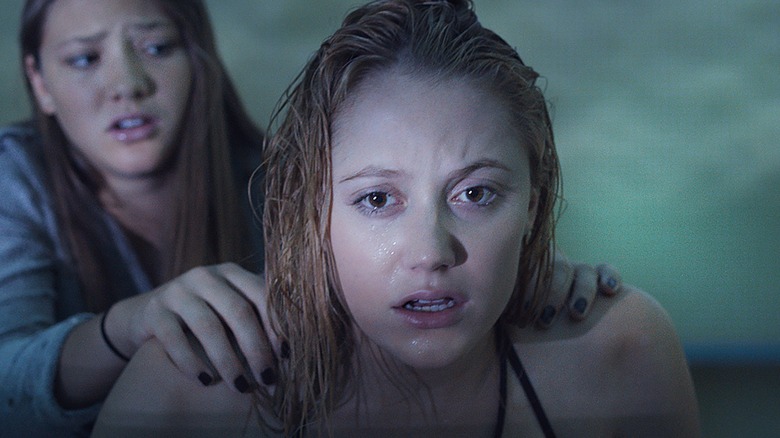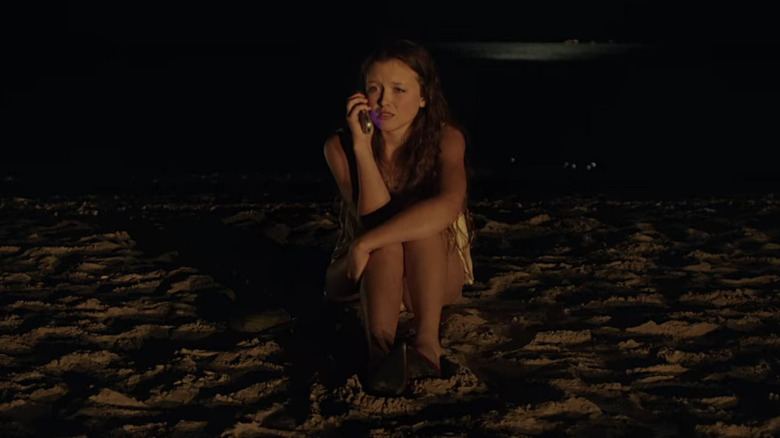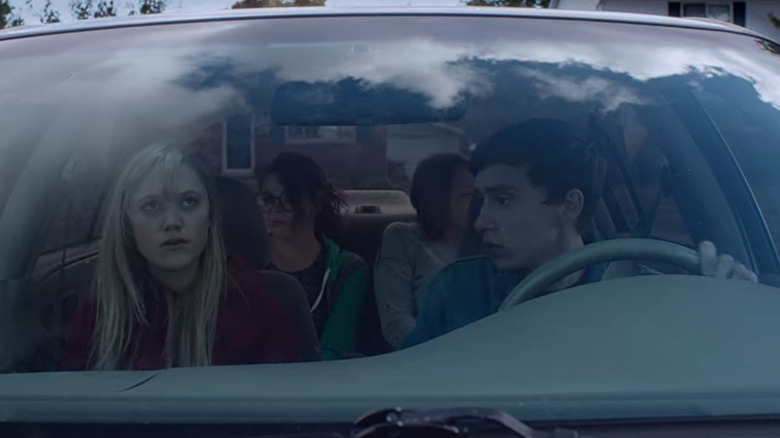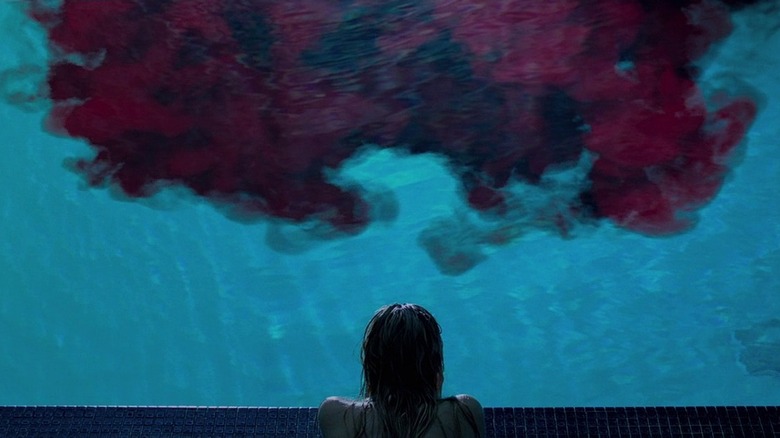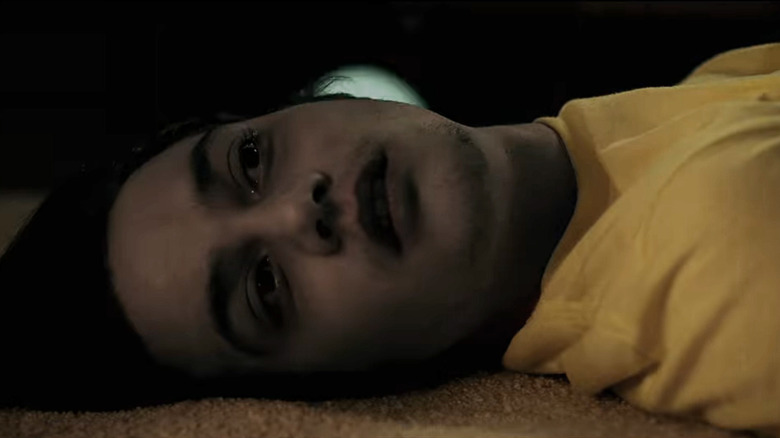12 Most Disturbing Moments In It Follows Ranked
The critically acclaimed 2014 horror film "It Follows" tells the story of a cheerful, aimless teen named Jay (Maika Monroe). After she has sex with a boy named Hugh (Jake Weary), he tells her that he has given her a terrible curse. Everywhere she goes, she will be followed by an inhuman entity. It can look like anyone, even people she knows, but only she can see it — and if it ever catches her, it's going to kill her in a truly horrifying manner. She can pass it along by sleeping with someone else, but if she does so, she will doom them to the same fate as hers.
For much of its runtime, "It Follows" is a somewhat understated affair, at least by horror movie standards. Our teen protagonists are generally kind to one another, there's a chilled-out synthwave soundtrack, and despite the seemingly expendable cast that surrounds Jay, there are very few deaths in the film. That being said, when this movie does decide that it's time for a scare, it is a masterclass in how to construct a moment that is profoundly upsetting.
Today, we're counting down the 12 most disturbing moments in "It Follows." To be clear, we're not necessarily talking about the moments that are the most scary the first time you see them. These are the more deeply unsettling moments that will continue to haunt you, even years after you've seen the film, often due to the fact that they are either inexplicably strange, thematically rich, or have dark implications. Along with this, we'll also offer some analysis as to why it is that we think these moments, in particular, are so affecting, and why this is a film often considered one of the best horror movies of all time.
12. Annie's death
"It Follows" opens in a sunny suburban neighborhood. Then, a young woman named Annie bursts out of her house and sprints down the street. Shrieking horror music plays. She's clearly running away from something, but nothing seems to be chasing her. Annie pauses and looks back towards the house, waiting for her moment. Eventually, she makes it into her parked gray sedan, then drives away.
Later that night, Annie sits by a lake. Her back is to the waves, and she's watching the road. Her cell phone rings and she answers it, and she tells her dad that she loves him. She then looks up, as if seeing something approaching, but a wide shot of the beach reveals nothing — just the sandy shore illuminated by the headlights of the car.
The next morning, everything is still, overcast, and gray. Annie lies dead on the beach, with one leg twisted around and snapped into an unnatural angle, a bone jutting out of the skin. Her face is relaxed and unreadable. We don't know what killed, but whatever it was, it was both fantastically strong and unfathomably cruel.
The shot of Annie's dead body is definitely the goriest image in the film. It's undeniably haunting. The only reason it's not higher on the list is because, by the standards of this film, it's a little obvious. Yes, a teenager's mangled body is indeed a sure-fire way of making audiences gasp, but as the film unfolds, it will reveal that it has far more insidious ways of making us suffer.
11. The woman in the hospital gown
Pretty much any time the entity shows up, it's disturbing in one way or another, in part because of how it chooses to present itself. One of the most subtly horrifying forms it takes is during its second appearance: an old woman in a hospital gown.
Even though death is common throughout horror films, it's quite rare to have a horror movie that is actually about death. "It Follows," however, is all about the actual terror of real death — its inevitability and inescapability. Sure, it's easy to outrun right now. It's not going to catch you today, and that's okay. It's in no rush. It will catch you, though.
Death is not a sharp-toothed monster covered in blood. It's mundane, patient, and unassuming. It's a perfectly nice-looking woman with a knee brace, slowly shuffling towards you. She's even in a hospital gown, which evokes thoughts of illness and infirmity. It's the worst thing there is, but it's also so normal that it's boring. The horror of this scene comes from the sudden intrusion of this imagery — old age and hospitals — into a school, a world of youth where everyone believes they're going to live forever.
The scariest thing about this moment, however, is not the fact that the entity itself is scary looking, because it's really not. It's not screaming like a monster, but on the other hand, it's not smiling like a friend, either. It simply "is." The horror is the overwhelming fact of its existence. Up until now, Jay hasn't fully believed that it's real, but this is the first time where she has to accept, like it or not, this thing undeniably "is," and it's never going to stop following her.
10. The naked man on the roof
This next moment is not only disturbing, it's also perhaps the most inexplicable moment in the entire film. After numerous frightening encounters with the killer entity, Jay and her friends have decided to try and turn the tables on their pursuer. The kids have gathered supplies to lay a trap from the creature, and as they are leaving Jay's house, Jay is taken aback by the sudden presence of a figure standing on her roof. He's an older man, standing perfectly still, and he's completely naked.
At first, this behavior seems rather out of character for the creature as we have known it so far. Why isn't it following them; why is it naked; and how'd it get up there, anyway? It's so unexpected that some audience members might even find this moment a little funny.
However, once the nervous chuckles cease, it's legitimately terrifying, because of how thoroughly alien this behavior is. At the moment when our heroes have finally come up with a plan to destroy the entity, just when they start to believe that they might have the upper hand on this being, now comes this utterly absurd moment that drives home the fact that both Jay — and we, the audience — don't know the first thing about what this creature really is.
It's still a little funny, though.
9. Jay's kitchen intruder
After seeing the creature at school, Jay's friends offer to spend the night at her place, to keep her company and watch her back. That night, as she and her friend Paul (Keir Gilchrist) sit on the couch, there's the sound of breaking glass from the kitchen. Paul goes to take a look and claims a window is broken, but apart from that, he doesn't see anything. He then runs upstairs to wake up Jay's sister, leaving Jay alone in the living room.
Alone and terrified, Jay slowly inches toward the source of the sound to get a closer look. She enters the kitchen in slow motion, framed in profile, as if oblivious to the gaze of something standing right next to her. She pauses for a beat, then slowly turns to face the camera. We then get the reverse shot: a woman with missing teeth and bruises around her eyes. Most of her clothing has been removed, and she wears only one sock on her feet. As she slowly approaches Jay, she is mindless urinating down her own legs.
It's a profoundly disturbing reveal, not just because of how upsetting the imagery itself is, but because of the way the surrounding scene is constructed. The film foreshadows the scare, builds it up, but withholds it far longer than the audience is expecting, even using slow motion to delay the reveal until the last possible moment. When it comes, the audience is practically clawing their own faces off with anxious anticipation. In an era of ubiquitous jump scare horror, this scene is a showcase for the power that comes from doing the exact opposite: forcing the audience to wait for the horror as it slowly inches towards them.
8. The fight on the beach
Midway through the film, the kids have gone out to a lake house that belongs to Greg's family, to try and put a little distance between them at the creature that is stalking Jay. However, this plan doesn't work, and before they know it, the entity has found them once again.
This time, however, Jay's friends try to fight back. Paul breaks a chair over it. It is unharmed, and it flings him across the beach with ease, leaving strange burn marks on his torso. They shoot it with a gun, and it collapses for only a moment before getting back up. They hide in a shed, and it breaks the door down.
It's one of the only full-on action scenes in the film, and the scariness of it comes from the sudden revelation that this seemingly sluggish entity is actually far beyond the capabilities of what any normal human can deal with. They can't hide, they can't run (at least not forever), and now it's clear that they certainly can't fight it.
7. The ambiguous final shot
At the end of the film, after the apparent death of the entity, we can almost believe for a moment or two that our heroes have done it, that they are truly free. Jay, after gently rebuffing Paul's affections throughout the film, now decides to finally have sex with him. Afterward, he asks her if she feels different, and she says, "No." She asks him the same question, and he also answers, "No."
Later, in the final shot of the film, Jay and Paul walk down the street, now holding hands. Far behind them, someone approaches, an unassuming figure in a coat.
Could it be the creature, back from the dead? Maybe. The bigger point is that, for the rest of their lives, they'll never know for sure. They may have found someone else to help carry their burden, but whether they realize it or not, they are different — not from the sex, but from everything else they've gone through. What's truly disturbing about this ending is the implication that, whether or not the monster still lives, this experience will follow them forever, and they'll never be able to stop looking over their shoulder.
6. The bearded man
In the climax of the film, our heroes have laid a trap for the creature in a public pool. When it finally arrives, the film withholds showing the creature for a bit. Only Jay can see what form it has taken, and when her sister Kelly asks her what she sees, Jay responds, "I don't want to tell you," but it's obvious from her trembling voice that whatever she's looking at is deeply disturbing.
When the film actually does show us what Jay is seeing, we see a man in an undershirt with dark hair and a salt and pepper beard. You might not catch it the first time you watch the film, but if you've been paying close attention, you've seen that man's face before, in various photographs hanging up around Jay's house.
The obvious conclusion to draw is that this man is her father, who is either deceased or, for some other reason, no longer a presence in Jay's life. This moment is disturbing because of how little it says, but how much it implies. Why is the presence of this man so terrifying to Jay?
5. The pool full of blood
After the creature has been defeated by a bullet to the head, it sinks to the bottom of the swimming pool, a cloud of blood trailing out of its skull. Before she starts celebrating, though, Jay crawls over the edge of the pool one last time to make sure the monster is dead. Perhaps she will see the corpse of the creature, perhaps she'll see nothing at all, or perhaps, in classic horror movie fashion, the creature won't be dead at all — and it'll grab Jay by the throat.
What she sees instead is far more terrifying than any of these options. Dark, thick, swirling clouds of blood have now filled up almost the entirety of the pool — far more blood than a creature that size should be able to contain. With these visuals come a cacophony of sounds, densely layered shrieking horror instrumentals that overwhelm our hearing as the growing stain overwhelms our vision, and it's somewhat unclear if these sounds only exist in the soundtrack, or if the characters are also hearing some version of these shrieks in the reality of the film.
Rather than feeling like a victory, it feels as though something evil and unfathomably huge has just been unleashed.
4. Jay getting chloroformed
Long before Jay encounters the worst of the supernatural terrors that await her, she is forced to endure a far more realistic form of horror: abuse at the hands of her romantic partner.
Jay and her new boyfriend Hugh have just had sex in the back of his car. As Hugh is retrieving something from the trunk, Jay lies facedown in the backseat, playing with a little flower growing up from the asphalt. She muses aloud about how much she used to look forward to adulthood, being old enough to date boys and drive a car. But now she has that freedom, and she realizes she doesn't know what she actually wants. Hugh then gets back into the car and lies on top of her. He holds her down and puts a rag in front of her face, forcing her to inhale chloroform. Jay loses consciousness, and her hand falls limp, grazing the top of that little flower one last time.
What's really poignant about this scene is how sweet and wholesome it is, up until the moment it isn't. Jay doesn't realize it, but this moment, lying here in the afterglow of sex, will be her last moment of freedom before she'll be forced to confront a new burden that will follow her throughout the rest of the film, and perhaps the rest of her life.
Viewing this moment this way — as innocent bliss interrupted by disturbing violence — supports an interpretation that "It Follows" is actually not a cautionary tale about the dangers of sex itself (unlike how some reviewers have interpreted it). It's clear from this scene that sex alone is not traumatic. The horror is the abuse, both when Hugh lies to her about his "condition," and when he knocks her unconscious.
If you or someone you know is dealing with domestic abuse, you can call the National Domestic Violence Hotline at 1−800−799−7233. You can also find more information, resources, and support at their website.
3. Jay swimming out to the boat
After the death of Greg, Jay gets in her car and drives for hours, presumably seeking to put some distance between her and the monster. Eventually, she stops on a nondescript rural road and gets a few hours of sleep on the hood of her car. When she wakes up, she discovers that she is by the edge of the lake, and out in the water are three young men on a boat. After a moment's consideration, she then strips down to her underwear and wades out into the water.
The next time we see her, she is driving back home, with wet hair and tears running down her face. Since the curse is passed along whenever someone has sex with someone else, this seems to be implying that Jay tried to buy herself a little more time by passing the curse along for a while, dooming one or more of these strangers to the same fate as hers.
It's a moment that's so brief and so out of character for Jay, compared to how she acts during the rest of the film, that it's tempting to ignore it entirely, but if you think through the implications of this moment, it's perhaps the most unforgivable act that we see any human character perform on screen.
2. Greg's death
There's only one time in the movie when we actually see "It" killing one of its victims. It's late at night, and Jay sees the monster invading Greg's (Daniel Zovatto) home, so she rushes over to save him. However, by the time she gets there, the intruder is already pounding on Greg's bedroom door, and it's taken the form of his mother in a revealing bathrobe. Jay warns Greg not to open his door, but he does so anyway, and the creature leaps onto him, pinning him to the floor and grinding against his crotch in an unmistakably carnal fashion. The lights flicker and the sound of crackling electricity fills the room. Greg lies still, his face inert and drained of color.
It's easy to imagine a version of this movie that never showed the audience what happens when "It" catches someone, and perhaps this reveal does diminish the mystery of the monster a bit. On the other hand, when the reveal is this unapologetically bizarre and perverse, it's tough to not be affected by it. Also, in some ways, our questions about this monster have now only increased. Why the sounds of electricity? Why did it look like his mother? Why the crotch grinding? It really drives home the idea that this movie has sexual abuse on its mind as a recurring motif, perhaps even specifically sexual abuse within a family. But what, exactly, is it trying to say? We aren't totally sure, but we're certainly disturbed.
1. Yara reading Dostoevsky (no, really)
Now that years have passed since the film's initial release, and we've had plenty of time to think it over, it's clear that the most haunting moment in the film is one that seems utterly mundane. After the creature has been apparently defeated, Yara's (Olivia Luccardi) friends are visiting her in the hospital as she recovers from the friendly fire bullet wound she sustained during the climactic battle. On her little handheld "shell phone," she reads aloud a passage from Dostoevsky's "The Idiot," the book she's been reading all throughout the film:
"When there is torture there is pain and wounds, physical agony, and all this distracts the mind from mental suffering, so that one is tormented only by the wounds until the moment of death. But the most terrible agony may not be in the wounds themselves but in knowing for certain that within an hour, then within ten minutes, then within half a minute, now at this very instant — your soul will leave your body and you will no longer be a person, and that is certain; the worst thing is that it is certain."
Unlike the horrors of the stalking entity that hunts Jay and her friends, the horror that Yara speaks of in this chapter is actually real. She's talking about death. As in, actual death in the real world. The true horror of "It Follows" is that it's about, among other things, the inevitability of death, and this is far scarier than any pretend monster that the film makes up. The most disturbing moment in "It Follows" comes when the film reminds us — all of us in the real world — that death is coming, and "the worst thing is that it is certain."
